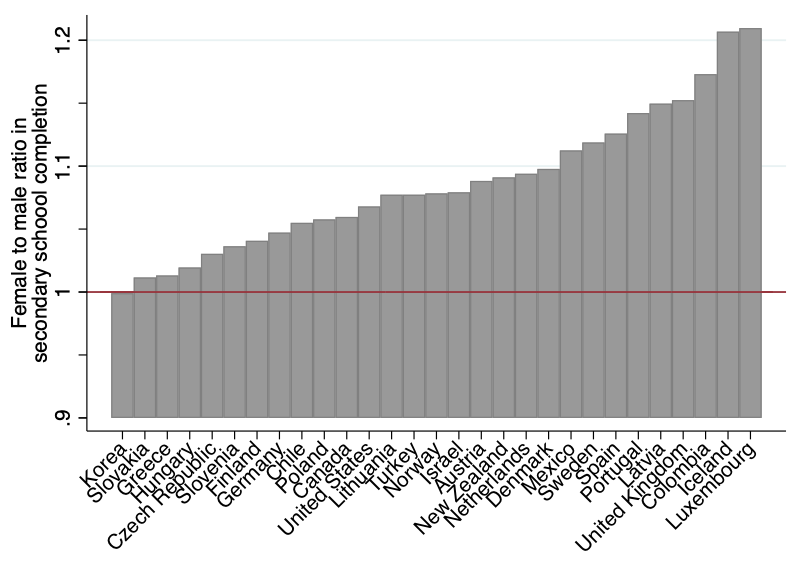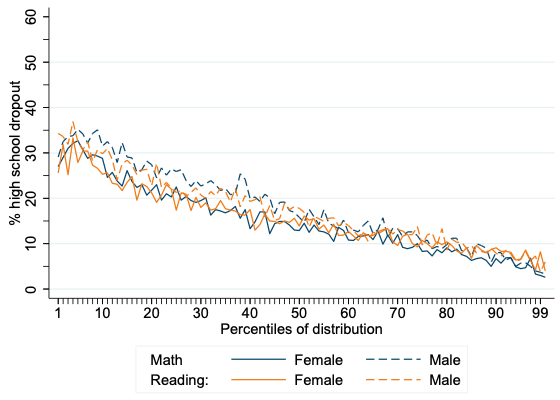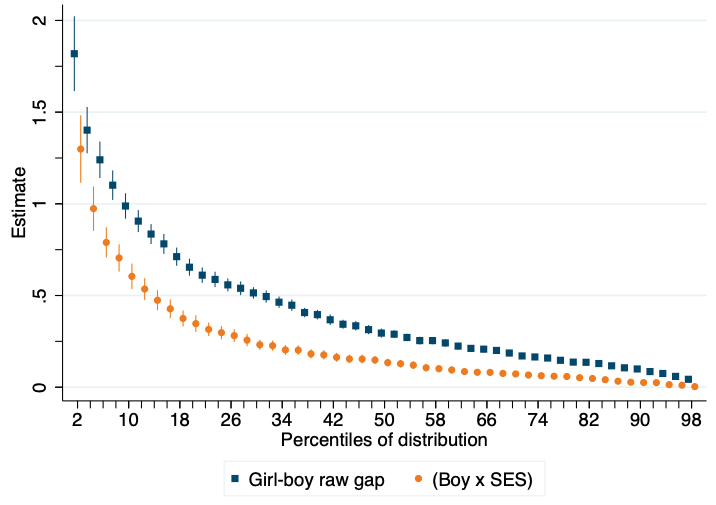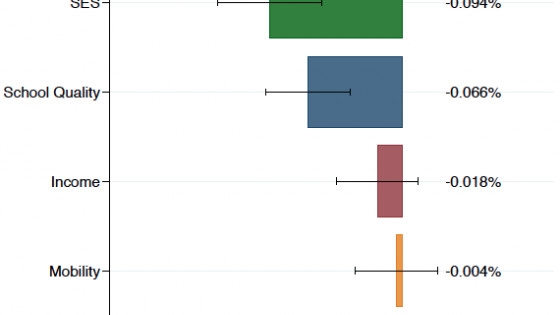Women have now surpassed men in most measures of educational achievement, including propensity to graduate from high school, to enrol in post-secondary education, and to graduate from college. For example, in 2010 the high school graduation rate among US women was 87%, while it was 81% among US men (Murnane 2013). These patterns are not unique to the US – as depicted in Figure 1, women outnumber men in secondary school completion in nearly all OECD countries (OECD 2020, Bertocchi and Bozzano 2020).
Figure 1 Female-to-male ratio in secondary school completion, OECD countries (2017)
Recent research has traced the evolution of these gender disparities from childhood. Indeed, a gender gap emerges in grade school, where girls tend to perform better than boys on reading standardised tests and are less likely to experience disciplinary incidents that result in suspensions from school. The determinants of these childhood gender gaps are extensively documented: family structure and living arrangements, family socioeconomic status, and school and neighbourhood quality have all been shown to differentially affect the outcomes of boys relative to girls (Bertrand and Pan 2013, Autor et al. 2016a, Autor et al. 2016b, Chetty et al. 2016, Autor et al. 2019, Lundberg 2017).
But these childhood gender gaps tend be of modest magnitude, which has led researchers to ask how they can lead to sizable gender disparities in eventual educational achievement. For example, data from the US state of Florida shows that girls maintain just a 0.15 standard deviation advantage, on average, in reading test scores. Even in behavioural outcomes, in which boys have long lagged behind girls, the gender gap in absences from school is, on average, just 0.45 percentage points, with both boys and girls attending more than 94% of school days.
We document two patterns that can help to explain why modest gaps between boys and girls in childhood outcomes translate into large differences in educational attainment (Autor et al. 2020). We leverage detailed administrative educational and birth records from the US state of Florida, which track public school students from birth through high school completion, for cohorts born 1992-2002. We first document that female-favourable gaps in test scores and attendance – a metric that combines both absences and suspensions from school – stem from the overrepresentation of boys among the lowest performing students. Although boys make up 49% of the overall sample, they comprise 55% of children at the 10th percentile of the reading test score and attendance distributions (Figure 2 Panel A). In mathematics, where boys have a small mean advantage, boys are clustered at both the lower and upper tails of the distribution (Figure 2 Panel B).
Figure 2 Male share throughout the attendance and test score distributions
A. Attendance
B. Test scores
Next, we show that poor childhood academic and behavioural outcomes are highly predictive of high school completion. Figure 3 illustrates that high school dropouts are drawn disproportionately from the lowest performing students. Children at the 10th percentile of the math and reading score distributions are almost four times as likely to drop out of high school as those at the 90th percentile. Furthermore, low-performing boys and girls have a similar likelihood of dropping out of high school, meaning that conditional on childhood school performance, there is only a small remaining gender gap in high school dropout rates. Given these patterns, examining why boys are overrepresented at the lower tails of the childhood outcome distribution may help explain why they are more prone to high school dropout.
Figure 3 High school dropout rate throughout the outcome distribution
A. Attendance
B. Test scores
Why is there a preponderance of boys among low-performing students? We focus on whether early childhood family environment has differential effects on boys – particularly those at the lower tails of the academic test score and attendance distributions. Our measure of family environment incorporates information on maternal education, maternal age at birth, family structure, and means-tested health insurance eligibility at the time of the child’s birth.
Our main finding is that the differential effects of family environment are concentrated in the parts of the outcome distribution where gender gaps are most pronounced. In Figure 4, we observe that at the 10th percentile of the attendance distribution, boys miss 1.06 percentage points more school days than do girls. A one standard deviation reduction in family environment can explain over half of this gender gap. A one standard deviation change represents, for example, shifting from growing up in a family with a mother who is an unmarried high school dropout to one in which the mother is a married high school graduate. Even in maths, a subject for which boys maintain a small mean advantage, the bottom quintile of the distribution is characterised by both a female-favourable gap in performance and differential effects of family environment on boys.
Figure 4 Effect of family environment on the gender gap in attendance throughout the distribution
Of course, a family’s socioeconomic status determines not only the immediate family environment but also the quality of schools that children attend and the attributes of neighbourhoods where children live. We find, however, that accounting for these correlates of family characteristics does not substantially lessen the disparate effects of family socioeconomic status on low performing boys.
How much of the female advantage in high school graduation can be explained by the differential effects of family environment on boys’ tail outcomes? To answer this question, we combine the gender-specific effects of family environment on elementary and middle school outcomes with the predictive power of these outcomes for high school graduation. Our calculations suggest that a one standard deviation increase in family SES can explain over 40% of the decile-specific gender gap in high school dropout. While our data do not permit analysis of outcomes past high school completion, the differential effects of family environment on low-performing boys’ K through 12 educational achievement – which is in turn foundational to subsequent educational and labour market performance – makes it likely that it contributes to longer-term disadvantage in outcomes such as adult earnings and labour force participation.
References
Autor, D, D Figlio, K Karbownik, J Roth, and M Wasserman (2016a), “School quality and the gender gap in educational achievement”, American Economic Review Papers and Proceedings.
Autor, D, D Figlio, K Karbownik, J Roth, and M Wasserman (2016b), “Quality schools can boost boys’ achievement”, VoxEU.org, 22 June .
Autor, D, D Figlio, K Karbownik, J Roth, and M Wasserman (2019), “Family disadvantage and the gender gap in behavioral and educational outcomes”, American Economic Journal: Applied Economics 11(3): 338–81.
Autor, D, D Figlio, K Karbownik, J Roth, and M Wasserman (2020), “Males at the tails: How socioeconomic status shapes the gender gap”, NBER Working Paper No. 27196.
Bertocchi, G and M Bozzano (2020), “The education gender gap: From basic literacy to college major”, VoxEU.org, 05 October.
Bertrand, M and J Pan (2013), “The trouble with boys: Social influences and the gender gap in disruptive behavior”, American Economic Journal: Applied Economics 5 (1): 32–64.
Chetty, R, N Hendren, F Lin, J Majerovitz, and B Scuderi (2016), “Childhood environment and gender gaps in adulthood”, American Economic Review Papers and Proceedings.
Lundberg, S (2017), “Father absence and the educational gender gap”, IZA Discussion Paper No. 10814.
Murnane, R (2013), “U.S. high school graduation rates: Patterns and explanations”, Journal of Economic Literature 51(2): 370-422.
OECD, "Education at a glance: Graduation and entry rates", OECD Education Statistics (database).













